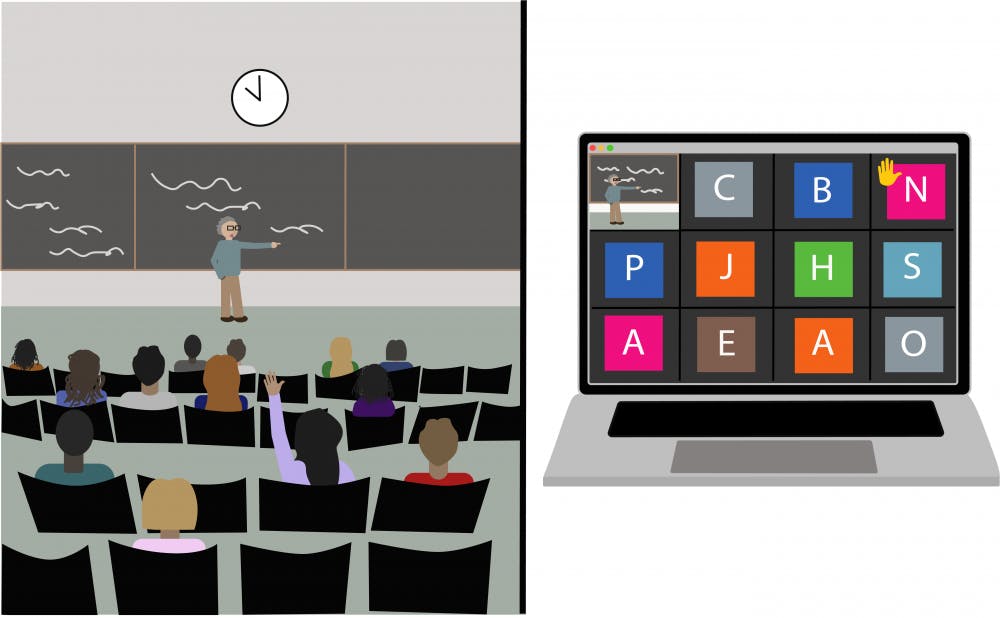With COVID-19 restrictions gradually lifting on campus throughout the summer, the upcoming fall semester is set to look much like a pre-pandemic term. Still, some hallmarks of the pandemic will remain, as some professors choose to offer their courses either fully or partially online.
One of these courses is BIOL 0030: “Principles of Nutrition,” taught by Associate Professor of Medicine Mary Flynn. The course will be entirely asynchronous, consisting of pre-recorded lectures. For Flynn, teaching a large introductory course of more than 100 students was simply better online than in person.
The flexibility of asynchronous learning was key for Flynn when deciding to teach remotely. Flynn noted that in a pre-pandemic semester, her classes were often scheduled to start before 9 a.m. “Students do not like this time for classes,” she wrote in an email to The Herald. A few weeks into the semester, she noticed that the classroom would often not be full, and students would be missing class. Ultimately, Flynn decided that continuing with remote teaching would be conducive to “better learning on the part of the students.”
For Professor of Sociology John Logan, the decision to teach his class, SOC 1330: “Remaking the City,” fully online rested on continued COVID-19 concerns and inclusivity and equity for remote students.
“I’m very concerned about teaching in person in a small, unventilated room,” Logan said. “I'm old enough that if I happen to get COVID, even though I'm vaccinated … I would be at much higher risk … of having a severe reaction.”
He also noted the difficulty of ensuring that all students are equally engaged in a discussion-based course. If some students were in-person, and others on Zoom, it could be hard to include the virtual students, he said.
“If you’re the person on the phone, you really have to shut up and listen until the person who is running the meeting asks you for your” comments, he added. Virtual students may find it difficult to chime into discussions, but “if we were all on Zoom, everybody would be equally included.”
Associate Professor of Computer Science Thomas Doeppner will be teaching CSCI 0330: “Introduction to Computer Systems” in the fall, which will offer a fully in-person option for those on campus and a separate section for remote students.
According to Doeppner, students on campus will be expected to attend lectures synchronously. While remote students will attend lectures asynchronously and be exempt from taking in-class quizzes, they will still be able to participate in other components of the class, such as office hours and group projects. Some office hours will continue to be offered online, both for remote and in-person students. Doeppner recognized that it is often more convenient to host classes online, adding that the proportion of in-person versus remote office hours will be adjusted as student preferences become clearer throughout the semester.
Regardless of the mode of teaching that faculty members plan to use for the fall semester, they all acknowledged that remote teaching has major downfalls alongside its benefits.
When remote learning first began in March 2020, Doeppner recorded his lectures without an audience so that his students could watch asynchronously. “I hated that. It was really terrible delivering a lecture just to your screen,” he said. He began to hold synchronous lectures over Zoom last fall, which he said was more “comfortable,” but far from ideal.
“I like to see people in class and better gauge how they’re reacting. … On Zoom, I will see maybe four people in a class of 300 or so … and it’s always the same four people — I don’t really get to see what the rest of the class looks like unless they come to my office hours.”
Echoing a similar sentiment, Logan mentioned that he disliked not being able to actually see his students.
Logan said that he misses the brief one-on-one conversations that he was previously able to have with students right after classes. He also found that students were less likely to visit him during office hours. Logan pointed out that, because students are only seeing each other on Zoom, they do not have the opportunity to get to know each other outside of class.
“That's a serious problem because I believe that a great deal of what happens in a university setting is that people meet and spend time talking to other people that they never would have known,” he said.
Despite planning to teach online in the fall, Flynn said that she will teach her spring semester class, BIOL 0040: “Nutrition for Fitness and Physical Activity,” in person, since it is more discussion-based. Flynn was teaching this course when University instruction first transitioned online in spring 2020, and she immediately noticed a difference in student participation.
“I had thought that the class was very interactive in person, but on Zoom, I found myself needing to coax people to contribute to the discussion,” she wrote to The Herald. She added that because it is so hard to interpret body language on Zoom, students could not freely “jump in” to conversations like they would be able to in person.
Logan expressed a different perspective on holding classroom discussions on Zoom. According to him, virtual classrooms have made it easier for him to gauge his students’ reactions. “I see everybody's face right there in front of you … I don't turn around and face the blackboard,” he said. As a result, he “has a better feel for what’s going on in the class.” Because his class also involves a student presentation component, being on Zoom has been easier on students who may be more shy doing class presentations in person.
Still, the professors recognized the importance of remote learning and teaching.
Flynn, who was originally not very confident in teaching online, realized the “distinct advantages” to remote learning, especially for large classes. “A month into (the class), from the quizzes … I suddenly realized that they really seemed to be getting it.” In a normal semester, there would always be students who “obviously haven’t studied,” but during a remote semester, Flynn noticed that students were performing much better.
“I was getting really interesting ‘thought questions’ by email,” said Flynn. Students “were taking the material, and they were applying it, and I don't expect that in the basic class.”
Similarly, Logan expressed that, after having taught in person for decades, he was convinced that in-person was the best method of teaching. But over the course of the pandemic, he began to realize the strengths of remote learning. “I’ve been very satisfied with teaching on Zoom,” he said. “I hesitate to say that it's better for the kind of course that I teach, but I think maybe it is.”

ADVERTISEMENT




